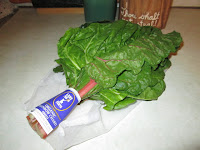However, a week or so ago, as I browsed through the aisles at the Whole Earth Center, looking for a suitable pick for my March Veggie of the Month, I spotted the chard once again, heaped high in the refrigerator case, and I thought, well, the whole point of this exercise is to try new things, right? So I selected the rainbow chard, which I found appealingly colorful and reasonably priced at $2.45 per bunch.
Then came the question of how to use it. Mark Bittman recommends sautéing it with oranges and shallots, but we didn't have any of those handy, and going out and buying additional ingredients just to make use of my Veggie of the Month seemed to run counter to the purpose of buying it, which is to try and find ways to work it into my usual diet. So Brian tried chopping up a leaf or two and incorporating it into the batter of some potato cakes. (These are the "Crabby Potato Cakes" from the Small Potato Cookbook, one of our regular standby recipes, except that we've taken to substituting canned tuna for the canned crabmeat since Trader Joe's stopped carrying the latter.) The chard didn't affect the flavor of the cakes much—mixed in with the potato, tuna, carrots, scallions, and other ingredients, I'd hardly have known it was there at all—but it did seem to make their texture a bit more crumbly. The cakes didn't hold together as well as usual, at any rate, and I assume the chard was responsible, since everything else about the recipe was unchanged.
Next he tried adding a few leaves' worth to some quesadillas. These were not a standard recipe but an improvisation on a regular theme; instead of making quesadillas as we usually do, with refried beans and Monterey Jack, he heaped the tortillas with mushrooms and chard before sprinkling on the cheese to bulk them up with nutrition-packed veggies. They came out pretty well, but once again, the chard didn't seem to make any distinctive contribution to their flavor. It just sort of blended in under the cheese, the shrooms, and the homemade tomato salsa (made with canned tomatoes, since the "fresh" tomatoes you can get at the grocery store in March are nothing of the kind).
After these two "stealth chard" recipes, I began to fear that I'd end up consuming the entire bunch of chard without ever having any idea what it actually tasted like. So I suggested to Brian that we cook up the remainder of the chard using the same recipe we use for dandelion greens: tossed with a dressing of hot fried bacon ends (from the Amish market), cider vinegar, brown sugar, and scallions. I figured that if this works for slightly bitter-flavored dandelion greens, it should be suitable for the chard as well. And it was—the tangy-sweet dressing and the brief heating softened the bitterness of the chard without concealing it completely. I found I liked the dish about as well with the chard as I normally do with dandelions.
From these three experiments with chard, it seems clear that we could easily incorporate this vegetable into our regular diet if we so chose. But after trying the chard in its various forms, we both had to admit that neither of us felt any particularly compelling need to buy it again. While the chard blended unobtrusively into the potato cakes and quesadillas, it didn't really seem to add any particular kick to either dish. And although it worked reasonably well in the wilted salad, it was no better than the dandelion greens, which we can get for free.
So, the bottom line with this month's Veggie of the Month appears to be that we no longer have any good reason to avoid chard particularly. If someone offers us a bunch for free, or if we join a CSA that gives us lots of it, or if we see a particularly good deal on it at the grocery store, we can be reasonably confident that we'll find ways to use it up. But we're not so crazy about it that we'll go out of our way to buy it, and we're certainly not about to give up any of our precious, limited garden space to it. Brian said that if we were to find it grows exceptionally well in our garden, it might be worth devoting a few squares to it just for the sake of a bountiful, if not exactly scrumptious, harvest. But speaking for myself, I'd rather devote those squares to arugula (which grows like gangbusters in our garden, and which is ludicrously expensive to buy at the store) or make another attempt to find a variety of spinach that we can grow successfully. Spinach has at least as many uses as chard does, and unlike chard, it's a veggie we'll actually eat for its own sake.






No comments:
Post a Comment